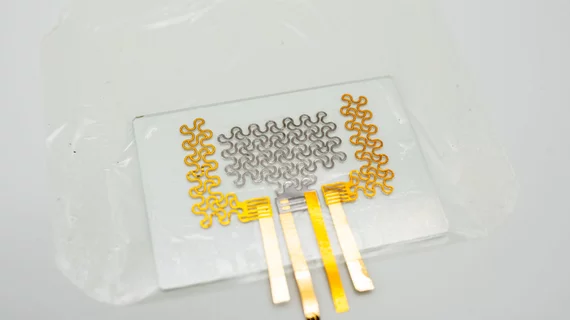E-tattoo combines ECG, SCG capabilities to track heart health
A team of University of Texas at Austin researchers are looking to replace the decades-old electrocardiography process with a more comprehensive, streamlined way to monitor heart health: e-tattoos.
Nanshu Lu, PhD, and colleagues’ electronic tattoo technology packs typical ECG capabilities plus seismocardiography (SCG) functions into a stretchable, lightweight patch no larger than 7 centimeters squared. Soft e-tattoos aren’t a new innovation, but other sensors—especially SCG sensors, which measure heart activity via chest vibrations—are clunky and can be uncomfortable to wear.
“There has been little progress in the development of soft SCG sensors,” Lu and co-authors wrote in Advanced Science, where their work was recently published. “Although SCG can be measured by mounting commercial accelerometers on the human chest, the thickness and rigidity of conventional accelerometers make them uncomfortable to wear and susceptible to the global inertial motion of the body.”
Still, Lu et al. didn’t want to lose the utility of SCG. ECG readings alone aren’t an accurate enough picture of heart health, and SCG tracks the accuracy of ECG measurements, acting as a kind of quality control.
The team combined both functionalities in a graphene-based wearable made of polyvinylidene fluoride, a polymer that’s capable of generating its own electric charge in response to mechanical stress. The device also includes 3D digital image correlation technology to help determine optimal tattoo placement.
“3D digital image correlation is used to map chest vibration to identify the best location to mount the e-tattoo and to investigate the effects of substrate stiffness,” Lu and colleagues wrote. “As piezoelectric sensors easily suffer from motion artifacts, motion artifacts are effectively reduced by performing subtraction between a pair of identical SCG tattoos placed adjacent to each other.
“Integrating the soft SCG sensor with a pair of soft gold electrodes on a single e-tattoo platform forms a soft electro-mechano-acoustic (EMAC) cardiovascular sensing tattoo which can perform synchronous ECG and SCG measurements and extract various cardiac time intervals including systolic time interval.”
The EMAC tattoo allowed for strong correlations between systolic and diastolic blood pressures and systolic time intervals, the authors said, making it a simpler way to track BP continuously and noninvasively. The device can be worn remotely for days at a time, as opposed to ECG monitoring, which takes place in shorter intervals and at the cardiologist’s office.
Lu and co-authors said their next steps include devising better ways to power the e-tattoo wirelessly for longer periods of time, as well as stepping up the device’s data collection and storage capabilities. They’re in the process of developing a compatible smartphone app.

